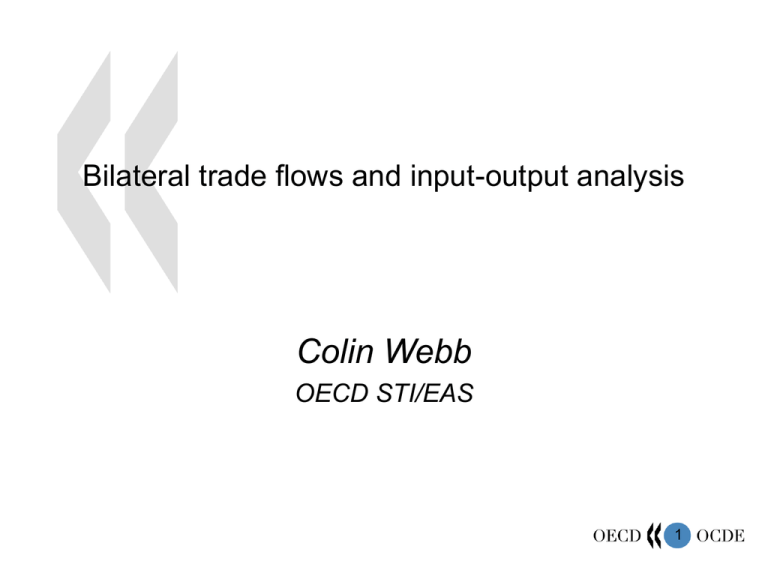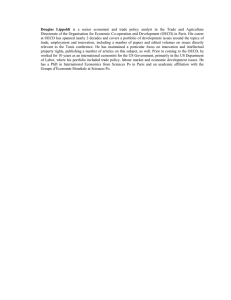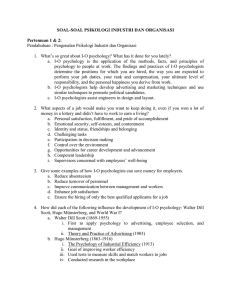Colin Webb Bilateral trade flows and input-output analysis OECD STI/EAS 1
advertisement

Bilateral trade flows and input-output analysis
Colin Webb
OECD STI/EAS
1
Introduction
3rd edition of OECD Input-Output (I-O) database
currently being finalised
‘Harmonised’ tables based around the year 2000
and expanded country coverage: 28 OECD countries
and 7 non-OECD countries
STI Working Paper 2006/7 by Wixted, Yamano and
Webb discusses a range of uses of OECD’s
‘harmonised’ Input-Output (I-O) tables
OECD’s Bilateral Trade by industry Database (BTD)
plays an important role
2
OECD I-O - increased global coverage
share of global GDP by edition
Share of global population by edition
100%
100%
90%
90%
80%
80%
70%
70%
60%
60%
50%
50%
40%
U.S.A.
30%
India
U.S.A.
20%
10%
0%
30%
20%
China
China
2002ed (1995)
2006ed (2000)
U.S.A.
1995ed (1995)
40%
Source: United Nations
10%
0%
1995ed (1995)
2002ed (1995)
2006ed (2000)
Source:
3
Basic domestic Input-Output table
Gross Outputat basic prices
Exports
Changes in inventories
Gross fixed capital formation
(GFCF)
Domestic
intermediate
matrix
4
Government consumption
1
Private domestic consumption
Domestic
investment (GFCF)
matrix
Total use of domestic products at basic prices
2
Imported intermediate products
Taxes, less subsidies, on intermediate products
Total intermediate inputs at purchasers prices
Value Added at basic prices (a+b+c)
3
a. Compensation of employees
b. Gross operating surplus
3
c. Taxes, less subsidies, on production
Gross Output at basic prices (i.e. total inputs)
Imported
intermediate products
matrix
5
Imported
investment (GFCF)
matrix
4
Role of trade data (1)
Create total transaction matrix by adding import
matrix to domestic transaction matrix
Import matrix generated by distributing total imports
across industries
Country source tables used where available
Otherwise, tables estimated at OECD
Bilateral trade may play minor role
5
Uses of National Tables
Simple structural analyses
By converting monetary values in transaction matrix to
coefficients (A), a range of nth order effects can be
modelled via Leontief inverse (I-A)-1:
Extent to which domestic R&D, or CO2 emissions (or
anything), is embodied in domestic output
E x (I-A)-1D
Impact of imported intermediates on productivity
Import content of exports
Service sector value added embodied in manufactures
6
Service sector value added embodied in manufactures
Early 1970s
30
Mid-1970s
Early 1980s
Mid-1980s
Early 1990s
Germany
Japan
Italy
Mid-1990s
%
25
20
15
10
5
0
Australia
Canada
Denmark
France
Netherlands
United
Kingdom
7
United States
Role of trade data (2)
BTD used to link national I-O tables. via trade flows
of goods, to produce international I-O models
BTD and I-O thus have compatible industry lists.
Imports by declaring countries are used to determine
shares from partner countries
For trade in services, much estimation required
8
Uses of Linked I-O Tables
Extending analyses of embodied technology, or CO2,
by including technology, or CO2, embodied in imported
goods
E x (I-A)-1D + ∑Ec x {Mc x (I-A)-1D +Dc}
‘adjusted’ measures of import content of exports
Identifying and analysing global value chains …
… impacts of international outsourcing (offshoring) –
on domestic employment, global greenhouse gas
emissions etc …
… inter-dependencies between countries; spatial
clusters
9
10
-30.00
Trade balance in CO2 emissions – percentage of domestic production
Total OECD
Other OECD
Russia
India
China
Brazil
United States
United Kingdom
Sweden
Spain
Poland
Norway
New Zealand
Netherlands
Korea
Japan
Italy
Hungary
Greece
Germany
France
Finland
Denmark
Czech Republic
Canada
Australia
-25.00
-20.00
-15.00
-10.00
-5.00
0.00
5.00
10.00
15.00
20.00
25.00
%
11
30.00
Limitations of data
Timeliness – I-O tables often released with lag of 5
years …
… and represent fixed point in time
Not enough detail for certain industrial sectors
Product to industry conversion keys can be flawed
Significant presence of re-exports / re-imports
Second-hand goods, recycled materials
Scarcity of bilateral trade in services by industry
12
Motivation
● Many Uses, but also many users …
● General increase in use of international linked I-O
●
●
models to address a wide range of policy issues
High and increasing demand for OECD ‘harmonised’
tables - Over 650 requests for 2002 edition in last 20
months
High response rate to an informal I-O users’ survey –
showing strong recognition of OECD’s contribution
13
Next Steps
● Finalise 2006 edition of OECD I-O tables
● Release technical documentation as STI working
●
●
●
●
paper
Disseminate new I-O tables (via OLIS etc)
Finalise HSISIC Rev.3 conversion in new system...
… then develop final versions of BTD tables for
‘major’ non-OECD countries
Co-ordination with other organisations to determine
feasibility of pooling resources for future development
of ‘harmonised’ I-O tables and related data tools.
14
How can trade statisticians help?
● Contribute to country source import matrices to
●
●
●
●
complement benchmark I-O tables
More information concerning re-exports / re-imports
Develop bilateral trade in goods by industry data
within national statistical offices
Continue improvements in trade in services data
Raise awareness of potential of international I-O
analyses and vital role of bilateral trade data
Thank you
15


